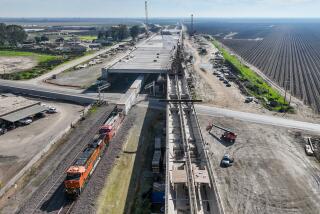Bernson Criticizes Growth Projection for Porter Ranch : Development: The councilman says the environmental study exaggerated the ultimate size of the project.
Los Angeles City Councilman Hal Bernson on Friday condemned as “grossly inadequate” a report assessing environmental impacts of a 20-year plan for shaping development in the Chatsworth-Porter Ranch area that was written by a panel Bernson had picked.
The report predicted that development permitted by the plan would cause more smog and massive traffic jams in the northern San Fernando Valley that could be alleviated only by spending millions of dollars on street improvements.
Bernson, the key political backer of a controversial development in the area, said the environment report exaggerated the size of possible development in the region and the harm it would do.
The draft environmental impact report “must be rewritten,” Bernson said in a strongly worded letter to the city Planning Department staff. The department is preparing to hold a public hearing Tuesday on the plan and its environmental report, which was released several weeks ago.
Frank Eberhard, deputy planning director, said Bernson cannot unilaterally order that an environmental impact report be rewritten. That decision rests with the Planning Department and the Planning Commission, he said.
Bernson said later that not only was he displeased with the report but that the plan itself might need to be revised. “The plan is not final; we can change it, roll back things,” he said.
But it was the environmental evaluation of the plan that was the primary target of Bernson’s ire.
The environmental report, Bernson said, often overstates the amount of growth proposed under the Chatsworth-Porter Ranch District Plan and fails to factor in the benefits of numerous scheduled traffic projects.
Moreover, Bernson said, the report studies the environmental impacts on a worst-case basis, which assumes that the city will allow construction of the maximum amount of development permitted by the plan. “We are not advocating or promoting” building the maximum, Bernson wrote to city planners.
Bernson is seeking election to a fourth term, facing seven challengers, the largest group of foes he has faced as an incumbent. The large field is inspired in part by a belief that Bernson is politically vulnerable because of voter resentment of his support for the 1,300-acre Porter Ranch project. The project falls within the area covered by the proposed plan.
Bernson said he fully expected his opponents to exploit the misperceptions he says are fostered by the environmental report.
“Of course, they’ll try to do that,” he said, but brushed aside further questions about the possible political pitfalls surrounding the report. “I really don’t want to get into the politics of this,” he said.
The Chatsworth-Porter Ranch District Plan was drafted by a citizens group picked by Bernson. The plan, an update of a 1974 Chatsworth District Plan, provides a blueprint for development in an area bounded by Roscoe Boulevard on the south, Tampa Avenue on the east and the city limits on the north and west.
The environmental report, which evaluates the effects of the proposed new plan, was prepared for the city by EIP Associates of Pasadena. Lori Valles, EIP office manager, said the firm had no comment on Bernson’s remarks.
Pointing to specific “deficiencies” in the report, Bernson said residents “shouldn’t be left with the impression we’re approving another 26 million square feet of commercial space” by adopting the plan.
The plan does call for a total of 26 million square feet of commercial development, but that includes space that has already been built and is only 800,000 square feet more than was approved by the 1974 plan, Bernson said. He did not know how many square feet of commercial space had already been built.
Also, the report fails to note that the new plan calls for a 50% reduction of industrially zoned property to 56 million square feet from the 1974 level of 112 million square feet, Bernson said in his letter to city planners.
In his letter, Bernson went on to criticize the report because it “virtually ignores the Simi Valley Freeway” and its traffic study relies on traffic counts at some intersections that “were taken as long as six years ago and are totally obsolete,” he said.
Bernson said the report does not take into account projected improvements to the Simi Valley Freeway and the benefits of synchronizing dozens of traffic signals, which are to be paid for by the Porter Ranch project.
More to Read
Sign up for Essential California
The most important California stories and recommendations in your inbox every morning.
You may occasionally receive promotional content from the Los Angeles Times.









